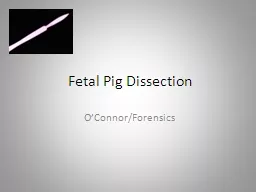

Gestation is 114 days in length 2 days or 3 months 3 weeks and 3 days Pig birth Taxonomy of Pig Kingdom Animalia Phylum Chordata Class Mammalia Order Artiodactyla Family ID: 694102
Download Presentation The PPT/PDF document "Fetal Pig Dissection O’Connor/Forensic..." is the property of its rightful owner. Permission is granted to download and print the materials on this web site for personal, non-commercial use only, and to display it on your personal computer provided you do not modify the materials and that you retain all copyright notices contained in the materials. By downloading content from our website, you accept the terms of this agreement.
Slide1
Fetal Pig Dissection
O’Connor/ForensicsSlide2
Gestation is 114 days in length (+/- 2 days) or 3 months, 3 weeks, and 3 days.
Slide3
Pig birthSlide4
Taxonomy of Pig
Kingdom: Animalia
Phylum:
Chordata
Class:
Mammalia
Order:
Artiodactyla
Family: Suidae
Genus: SusSpecies: Sus
DomesticaSlide5
Pig Litter
The average number of piglets/litter used to be 12-14
Currently they have been bred to deliver an average of 16 piglets.Slide6
Orientation
The following words will be used to help identify the location of structures.
Anterior
refers to the head end. If a structure is anterior to another then it is closer to the head.
Posterior
refers to the tail end.
Dorsal
refers to the back side. The pig in the first photograph below is laying on its dorsal side.
Ventral is the belly side. It is opposite the dorsal side. Slide7
Physical Description
A typical pig has a large head with a long snout which is strengthened by a special
prenasal
bone and by a disk of cartilage at the tip.
The snout is used to dig into the soil to find food and is a very acute sense organ. There are
four
hoofed toes on each foot, with the two larger central toes bearing most of the weight, but the outer two also being used in soft ground. They are quadruped, walking on all fours
. Epidermal skin is on surface & cut in dissection. The skin has appendages, most common is hair.
The dental formula of adult pigs is 3.1.4.3 in each jaw, giving a total of 44 teeth. The rear teeth are adapted for crushing. In the male the canine teeth form
tusks.Slide8
Description continued
Pigs eat both plants and animals, making them Omnivores
They walk on hooves so they are
unguligrade
.
(walk on toes/
digitigrade
- walk on flat/
plantigrade)
The openings in their nose are known as nares.Pinnae is the long fold in the ear.
Hair is course and unevenly distributed on body.
Fat distribution is much like humans & the skin is also similar.Slide9
Virtual Dissection
dissection tourSlide10
Ultimate Pig Review
Biology Corner Pig ReviewSlide11
Preparation and Initial Cuts
Tie one front leg of the animal with a string that passes underneath the dissecting pan to the other leg. Repeat this with the back leg.Slide12
First Cut
Insert one blade of scissors through the body wall on one side of the umbilical cord and cut
posteriorly
to the base of the leg as shown in the first photograph. Continue cutting from the anterior end of this cut so that it resembles an upside-down U. Your finished cut will be anterior to the navel and along each side of the navel. The flap of body wall that contains the navel can be folded
posteriorly
to reveal the internal organs of the abdomen.Slide13
First cut photo’sSlide14Slide15Slide16Slide17Slide18Slide19Slide20Slide21Slide22Slide23Slide24